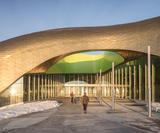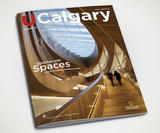
Discovering Traditional Indigenous Wellness Practices
By Mark Witten
Dr. Karlee Fellner, PhD, co-developed an innovative program called Poo’miikapii: Niitsitapii Approaches to Wellness as one of two new Indigenous interdisciplinary Master of Education programs being offered through the Werklund School of Education. Poo’miikapii is a Blackfoot phrase that means “collective harmony, unity and balance,” while Niitsitapii is the traditional word for Blackfoot, meaning “a person of truth.”
Fellner, who is Cree/Métis, says the program takes place mainly on the Kainai First Nation (Blood Tribe) reserve at Standoff, north of Cardston and southwest of Lethbridge.
“A big impetus for the program was my doctoral research, which focused on how health services need to be altered to better serve Indigenous people by further empowering traditional Indigenous approaches to wellness,” says Fellner, an associate professor in Indigenous education counselling psychology, who collaborated with the Elders’ Advisory Council at Red Crow Community College (RCCC) to establish this program. “This program offers professional development and educational training in Blackfoot approaches to wellness for educators, health-care professionals and other service providers and community members.”
Grad students enrolled in this experiential four-course program participate in traditional Indigenous practices such as equine therapy, bison harvests, sweat lodges, smudge ceremonies and plant harvests that promote emotional, physical, spiritual and mental wellness. The traditional Blackfoot ceremonies are collective efforts and students learn by actively contributing, as well as by observing and participating in rites and rituals.
“Students pick saskatoon berries used to make ceremonial food and pick sweetgrass, one of the important Blackfoot medicines. They help build the sweat lodge and put together the feast, and participate in the sweat ceremony,” says Fellner, who also co-developed a second Indigenous MEd program with Lauren Monroe Jr. of the Amskapi Piikani in Montana centred on Blackfoot ways of living in relation to language, history, politics, art and storytelling.
The Poo’miikapii capstone course, Iihpkim Mootspi, addresses “passing on the teachings one has received” through a service-learning project that has a direct and immediate benefit to the community. “Our students come from different disciplines and backgrounds, both Indigenous and non-Indigenous. There are teachers, social workers, nurses, psychologists and counsellors,” says Fellner. “The program empowers them with the knowledge to give back to their communities and each student is able to apply this in different ways in the capstone course.”
Tisha Wadsworth, who completed the Poo’miikapii program last year, applied the teachings she received by working with Cara Black Water, a Kainai High School counsellor, to set up and run a support group for Blackfoot girls.
“With this project, we’re trying to identity build in our young girls,” says Wadsworth, now a community wellness co-ordinator with the Kainai Board of Education. “We’re seeing in our community a lot of the dysfunction from residential schools, intergenerational trauma and loss of language and culture, which shows up in the opioid crisis, suicides, and alcohol and drug dependence. Our objective with the girls’ support group is to instill self-pride in being a Blackfoot woman so they can go out in the world with confidence, overcome trauma through resiliency, and be guided by the traditions.
“It’s been an amazing experience to go through the Blackfoot approaches to wellness programs and learn how we, as a community, need to move forward and heal the loss of language and culture. I want to be part of the solution and this program, supported by Blackfoot elders’ guidance, gives us so many ideas about ways to heal and support our community.”
There all sorts of other ways to bridge cultural gaps, from attending a powwow to checking out our events that we post at ucalgary.ca/nativecentre. You can learn more about UCalgary’s Indigenous Strategy, ii’ taa’poh’to’p, and its many activities and opportunities by visiting www.ucalgary.ca/indigenous-strategy

The Future of Architecture
Right in the heart of downtown, UCalgary’s Faculty of Environmental Design recently opened a 29,000-square-foot satellite campus, a.k.a. the City Building Design Lab (CBDL). Explore the spaces being designed and shaped by UCalgary Alumni.

How Do We Protect the Most Vulnerable?
With a willingness to take on entrenched and challenging urban issues, UCalgary alumni, students, faculty and researchers are assisting those who live on the margins.

Notebook
What’s transformed the Dining Centre is far more than a slap-happy menu makeover; we asked Vivek Shraya for her ideal party-invite list; gatecrashing the art gallery world; what’s in a name when it relates to Indigenous peoples; inside the mind of a literary icon.

Can’t Get Enough?
From splashy architectural photo spreads of some of Calgary’s most-talked-about new buildings to the complexities we face in caring for society’s most vulnerable — this issue explores UCalgary’s reach around the city and beyond.
